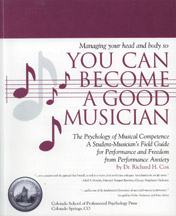 “Feeling nervous before a performance is normal,” says Dr. Richard Cox, a musician, music educator, and psychologist at the Colorado School of Professional Psychology.
“Feeling nervous before a performance is normal,” says Dr. Richard Cox, a musician, music educator, and psychologist at the Colorado School of Professional Psychology.
A certain amount of “concern” is probably good, normal, and useful, Cox continues, but anxiety is a physiological hindrance to good performance.
When the nervous system registers “anxiety,” it has already started the process of trembling, shallow or rapid breathing, perspiring, and stomach discomfort.
If these physiological symptoms are present, the first note will not be at its best. Cox suggests in his book Managing Your Head and Body So You Can Become a Good Musician that the psychology and physiology of anxiety can be greatly reduced by paying attention to these basics steps:
Mental Preparation
- Anticipation–This is a matter of mind imaging. Close your eyes and visualize the music on the page, you with your instrument, the group or accompanist with whom you are playing, and the audience. Create a small picture show in the front of your brain. If you have a difficulty doing this, close your eyes, find a “center spot” in the middle of the inside of your forehead, and picture the entire situation as if it were a cartoon being shown frame by frame.
- Relaxation–The body responds to anxiety by tightening up. If you have difficulty relaxing naturally, there are simple exercises that help. For example: Sit in a comfortable chair, or lie flat on a bed. Close your eyes. Breathe slowly and regularly, very deeply, and count slowly from one to 10, breathing in and out very slowly on each count. Talk to yourself. Tell yourself that with each breath you will become more and more relaxed.
- Performing in your mind–By going through the performance step by step you can anticipate surprise feelings. It is very much like anticipating the next note when we play. The best way to play the next note correctly is to anticipate how it will be executed and how it will sound within the context of the last note and then the next several notes.
- Center on the message–It is important to remember the message we wish to send to the audience. The audience will not remember the “wrong” notes nearly as much as they will remember the communication. Think through how the music will send the desired message. Then by keeping that message in mind, we can allow the technical performance to call upon years of practice and musical preparation. Many great musicians memorize the actual music straight from the printed page in their head, while humming it, and actually doing the fingering manually, then they put it all together in their mind, and only then on the instrument.
- Center yourself–Get in touch with your emotions. If you are preoccupied, the music will show it. It is absolutely necessary to “get lost” in the music, otherwise you become a show person, not a musician. The “centering” technique discussed under Anticipation will work here. Deep meditation is also helpful as this aspect of mental preparation requires whole brain activity. You should be keenly aware of the intellectual and emotional demands upon you and the alertness and confidence you have stored up during practice. Fifteen minutes of meditation with relaxation, twice daily, is a tonic that cannot be equaled by medicine!
Physical Preparation
- General health–Keeping one’s body in tone is essential to best performance. After all, the instrument is only an extension of your inner self. If you feel well physically, you will communicate better. It is surprising how many musicians abuse their bodies with inadequate exercise, too much caffeine, alcohol, tobacco, illegal and prescription drugs, and excess weight.
- Nutrition–You are what you eat. Food plays a far more important role in good performance than most musicians acknowledge. Too much sugar, excessive caffeine, and excess fats are only a few of the things to avoid. Regular eating is difficult for professional musicians due to performance times, travel, and scheduling. However, it is important to keep your blood sugar level under control and within normal limits at all times.
- Sleep–Loss of sleep produces serious effects. In fact, tiredness is only a symptom of the real problem–dream deprivation. When we do not sleep regularly, we develop sleep habits that skip important phases of sleep. One of these phases is the stage in which we dream. Dreams are essential for the repair of our entire thought process system. It also is particularly difficult for many musicians to obtain enough sleep before midnight. Research has shown that one hour of sleep before midnight is worth two hours after midnight. Some performers turn to medication and drugs to help them, but sleep that comes as a result of chemicals is not natural and does not produce the same beneficial results.
Other Considerations
- Beta Blockers–All medicines are drugs and have both beneficial and harmful effects. Medicines containing beta blockers are used by some musicians to control stage fright. However, these medicines work by blocking certain impulses to the heart and can have profound effects upon the heart and nervous system that controls the entire cardiovascular system.
- Other Medicines–The side effects of common medicines can dry you out (diuretics), make you drowsy (antihistamines), make you jittery (some cold and flu medications), cause nausea (some antibiotics), and some keep you awake. There are thousands of side effects of medicines you need to take into account. Medicines can also become a habit, both psychologically and physically. Be sure to discuss all the side effects of any medication you take, whether prescription or over-the-counter, with your doctor.
- Doctors–Be sure your doctor knows you are a musician and understands that treatments and medications can effect your ability to study and perform. When undergoing surgery, if at all possible, request local anesthetic. General anesthesia puts the nervous system of the whole body to sleep and usually requires considerably more time to “bounce back.”
- Dentists–If you are a wind instrument player, remind your dentist that your lips need to be treated gently. Even small changes in tooth structure, muscular ability, dry mouth, and myriad other considerations can effect your playing.
- Your Brain & Music–Thinking about how your brain functions when you produce music will help you balance your artistic interpretation with your technical abilities. The two sides of your brain are called “hemispheres.” The left side is known for its analytical functions–putting the technical aspects of playing together. It is where we have logic and order. Right brain activity is emotive, artistic, romantic, and creative. Learning to truly listen to and appreciate what music does to the psyche and the soul is important to the right side of the brain. When the brain is functioning as a whole–connected by the structure that bridges the hemispheres, called the “corpus callosum”–you are in a great place to artistically perform with correct technique.
- The Whole Person–The concept of wholeness, or holistic thinking, encompasses the mind, the body, and the spirit. It includes what you think, what you do, how you feel, what you believe, how you relate to others, and many other aspects of your total being. The concept seems rather esoteric at first, until you see how you fit into it. You cannot appreciate the role of music in everyday life, and your role as a musician, until you understand the meaning of the whole person. Once you grasp that concept it will be amazing how much easier it is to communicate with others and allow your music to touch the lives of others.
Adapted from Managing Your Head and Body So You Can Become a Good Musician, by Dr. Richard H. Cox, Colorado School of Professional Psychology Press, Colorado Springs, CO, 2006.




